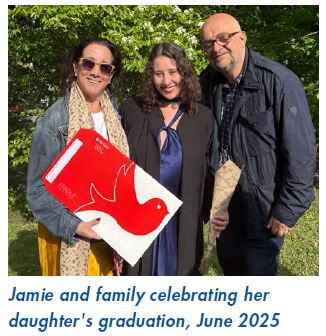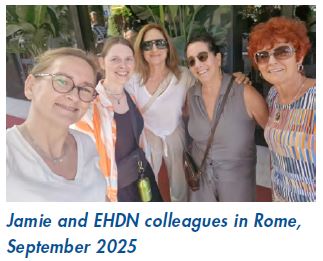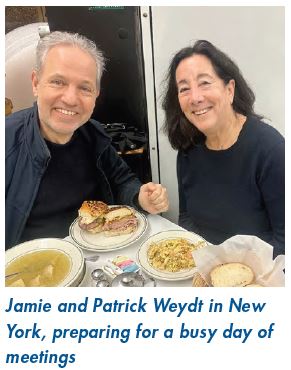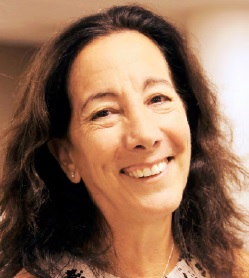|
|
Guided by Purpose: Jamie Levey
|
Highlight from the: EHDN Newsletter_November2025_Issue56
As Chief Operating Officer since 2005, Jamie Levey has been a cornerstone of the European Huntington’s Disease Network from the beginning. Her dedication, energy and leadership have been instrumental in shaping the organisation we are incredibly proud to be part of today. In 2014, Jamie shared her personal reflections as a member of an HD family with EHDN News readers.
Now, in 2025, she looks back on two decades with EHDN and considers the future of HD research.
Tell us about your early career and influences
When my mother started receiving clinical care for HD, I was in my early 20s and studying abroad at the Universidad de Sevilla. Many people hadn’t heard about HD at this time, and the causative gene was yet to be discovered. To learn as much as I could about the disease, I attended events hosted by Nancy Wexler, who was a professor at Columbia University, and continued to follow her work and that of the Hereditary Disease Foundation [HDF], founded by her father, Milton Wexler.
As we started out in our adult lives, my siblings and I knew about the risk of inheriting HD, but our main concern was caring for our mother rather than ourselves. Over the next ten years or so, we began to think about getting married and starting our own families. At 29 years old, I decided to undertake the HD biomarker test. The results were negative, and confirmed again as negative following the discovery of the gene in 1993, which, of course, made direct genetic testing possible.
By this stage, I was working in finance with biotech companies and keeping in touch with Ethan Signer and Allan Tobin, who were advisors at HDF. During my maternity leave several years later, I began thinking seriously about my career direction. I came to the realisation that I wanted to dedicate my professional life to HD, utilising my background in finance and consultancy in life sciences.
How did you get involved with EHDN?
In the early 2000s, I spoke with Ethan and Allan, who were now advisors for the newly established High Q Foundation – later to become CHDI – led by Robi Blumenstein. I met with Robi, and around the same time, I was moving from New York to Paris. Robi suggested that I meet with Bernhard Landwehrmeyer, who was leading a small CHDI-funded initiative called the European Huntington’s Disease Network, with a view to taking up the operational and business aspects. I immediately recognised Bernhard’s scientific vision and saw how our skills would complement each other.
I joined EHDN in 2005, when Bernhard had already established connections with countries including Germany, Italy, Spain, France, the UK, Portugal, and the Netherlands. We were a small team and had just started REGISTRY. We continued to grow the network and expand the study, which in 2014 officially transitioned into the global Enroll-HD study. Meanwhile, I moved back from Paris to New York. My brother and sister were both in the advanced stages of HD, and I wanted to be closer to my family.
What other activities were developed at this time?
Under the direction of the EHDN Executive Committee, we strengthened Central Coordination – the operational endorsement, making recommendations to the Executive Committee.
 |
 |
|
What are the links between EHDN and CHDI?
EHDN is a research project based at Ulm University and is funded by CHDI. CHDI is a 501(c)(3) organisation in the USA. Our missions are clearly and closely aligned, and as such, we have CHDI representation on the EHDN Executive Committee via Robi and, more recently, Emily Gantman.
A key part of my role is to bridge the gap between EHDN and CHDI, as well as among their respective committees and groups. Although we are separate entities, we are closely linked, sharing a common vision and working together extremely well.
 |
 |
What is your involvement in Enroll-HD?
From 2012, as the global aspirations for Enroll-HD became a reality, I took on a broader director role on behalf of CHDI. I partnered with Tim McLean, who was already wellentrenched in clinical operations for both studies. Together with CHDI and EHDN colleagues, we developed what is now known as the Enroll-HD Platform.
Fast forward to the current day, and I am very excited about Enroll-HD 2.0. I believe the protocol amendment is long overdue – we know that you are born with the genetic mutation, that HD is a lifetime disease, and its effects begin long before clinical symptoms appear. Research in recent years has confirmed what many of us in HD families already suspected about the impact of early disease-related changes. Enroll-HD 2.0 will help us map the early disease trajectory with unprecedented clarity – and this is critical for drug development efforts.
| ‘Enroll-HD 2.0 will help us map the early disease trajectory with unprecedented clarity – and this is critical for drug development efforts.’ Jamie Levey |
What are your views on the future of HD drug development?
Like many in the HD community, I was thrilled by uniQure’s topline results in September, and the recognition of the value of Enroll-HD through the use of these data as a comparator. This potential disease-modifying therapy for HD may mark the beginning of a new era. Of course, there is a lot of work ahead, and it won’t all be rosy. Clinical development is fraught with setbacks, as we have seen with tominersen. Yet every trial – positive or negative – advances our understanding. This is a particularly hopeful and pivotal time for the HD community.
| ‘Our HD community is fantastic in advancing, collaborating and sharing knowledge across the globe. I am very proud to be a part of it.’ Jamie Levey |
Data from Enroll-HD 2.0 will undoubtedly be a powerful tool in future HD drug development, particularly by informing discussions with regulatory authorities. We also anticipate further advances in utilising Enroll-HD data for comparative purposes in innovative, flexible approaches to drug development. Ultimately, all this work also aims to improve clinical care. Our HD community is fantastic in advancing, collaborating and sharing knowledge across the globe. I am very proud to be a part of it.
What will the next EHDN plenary meeting offer?
We plan to build on the success of the EHDN and Enroll-HD 2024 meeting in Strasbourg and the integration of a clinical development programme. The Programme Committee is chaired by Hoa Nguyen and Nayana Lahiri from EHDN’s Executive Committee, and Franziska Steck and Franziska Bernsdorff from Central Coordination lead the Organising Committee. We are also supported by Jerry Turner and his team at CHDI.
Going forward, we plan to have a collaboration between CHDI and EHDN for biannual plenary meetings – such as Strasbourg 2024 – and on alternate years, a collaboration between CHDI and the Huntington Study Group, as seen in Nashville 2025. These meetings provide an excellent complement to CHDI’s annual HD Therapeutics Conference, which is typically held in Palm Springs and dedicated to preclinical and translational research.
Looking ahead to Krakow 2026, the meeting will retain familiar features, including the EHDN Business Meeting and a strong emphasis on clinical trials. Presentations will highlight ongoing and upcoming studies, as well as cutting-edge scientific developments as we launch Enroll-HD 2.0.


